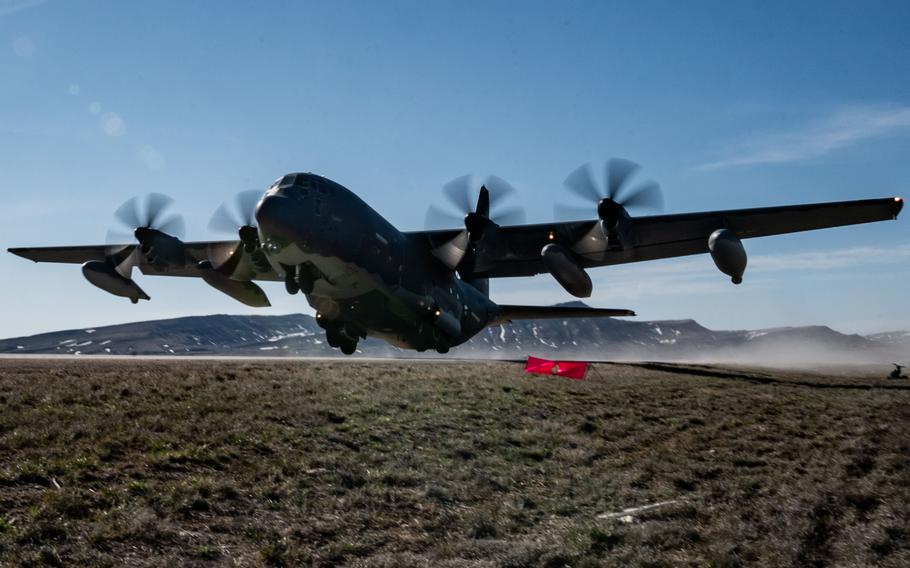
An MC-130J Commando II takes off from a state highway near Rawlins, Wyo., during Exercise Agile Chariot on April 30, 2023. Crews used the public road for the exercise as part of the Agile Combat Employment concept. (Carly Kavish/U.S. Air Force)
U.S. Air Force special operators broke ground this week when they landed planes on highways in Wyoming, marking the latest effort by commandos experimenting with ways to ensure that air power can be delivered when airfields aren’t an option.
During Exercise Agile Chariot, the Air Force for the first time landed an MQ-9 Reaper drone on a highway along with an MC-130J Commando II, two A-10 Thunderbolt IIs and two MH-6 Little Birds, the 1st Special Operations Wing, headquartered at Hurlburt Field, Fla., said in a statement Tuesday.
Lt. Col. Dave Meyer, deputy mission commander for the exercise, said the operation was unprecedented in terms of size and the number of aircraft making the roadside landings.
“An adversary that may be able to deny use of a military base or an airfield is going to have a nearly impossible time trying to defend every single linear mile of roads,” Meyer said. “It’s just too much territory for them to cover, and that gives us access in places and areas that they can’t possibly defend.”
The operations were carried out Sunday and Tuesday by Air Force special operations teams, who built on recent efforts in Sweden and Latvia, where smaller roadside landings have taken place.
Air Force Special Operations Command’s Lt. Gen. Tony Bauernfeind said the aim in Wyoming was “to hone the skills required to win a near-peer-competitor fight.”
Such maneuvers would likely be critical in any potential military showdown with Russia or China, which could target airfields and other military infrastructure that the Air Force typically relies on to launch and land aircraft.
For the Air Force, the drills are an extension of the Agile Combat Employment concept, which has become a strategic focal point as the military looks for ways to keep powerful adversaries off balance.
During the past year, Air Force Special Operations Command has been testing other unconventional ways to deliver airpower.
For example, in November, U.S. special operations forces flew over the Arctic and rolled a long-range missile out the back of a C-130, dropping it by parachute before it blasted toward its target.
That marked the first ever demonstration in Europe of Rapid Dragon, an experimental program that uses standard air drop procedures to launch air-to-surface cruise missiles.
Part of the Wyoming exercise focused on the 15th Special Operations Squadron’s landing of an MC-130J Commando II with two MH-6 Little Birds on Wyoming’s state Route 789, where it did a quick reaction personnel recovery mission, the military said.
Meanwhile, landing the Reaper on a highway has opened the door for future capabilities, military officials said.
“The MQ-9 can now operate around the world via satellite launch and recovery,” said Lt. Col. Brian Flanigan, the 2nd Special Operations Squadron’s director of operations.
Highway landings are far from unprecedented for military pilots. But the remote Wyoming roads served as a testing ground for the MC-130J to practice resupplying other assault aircraft.
Such capability reduces the need to have a large logistical footprint or haul supplies more slowly by road, said Maj. Matt Waggy, the exercise’s director.
“It’s a major step in the right direction. … Our joint force commander can now look at these capabilities as very real options to solve real-world problems,” Waggy said.